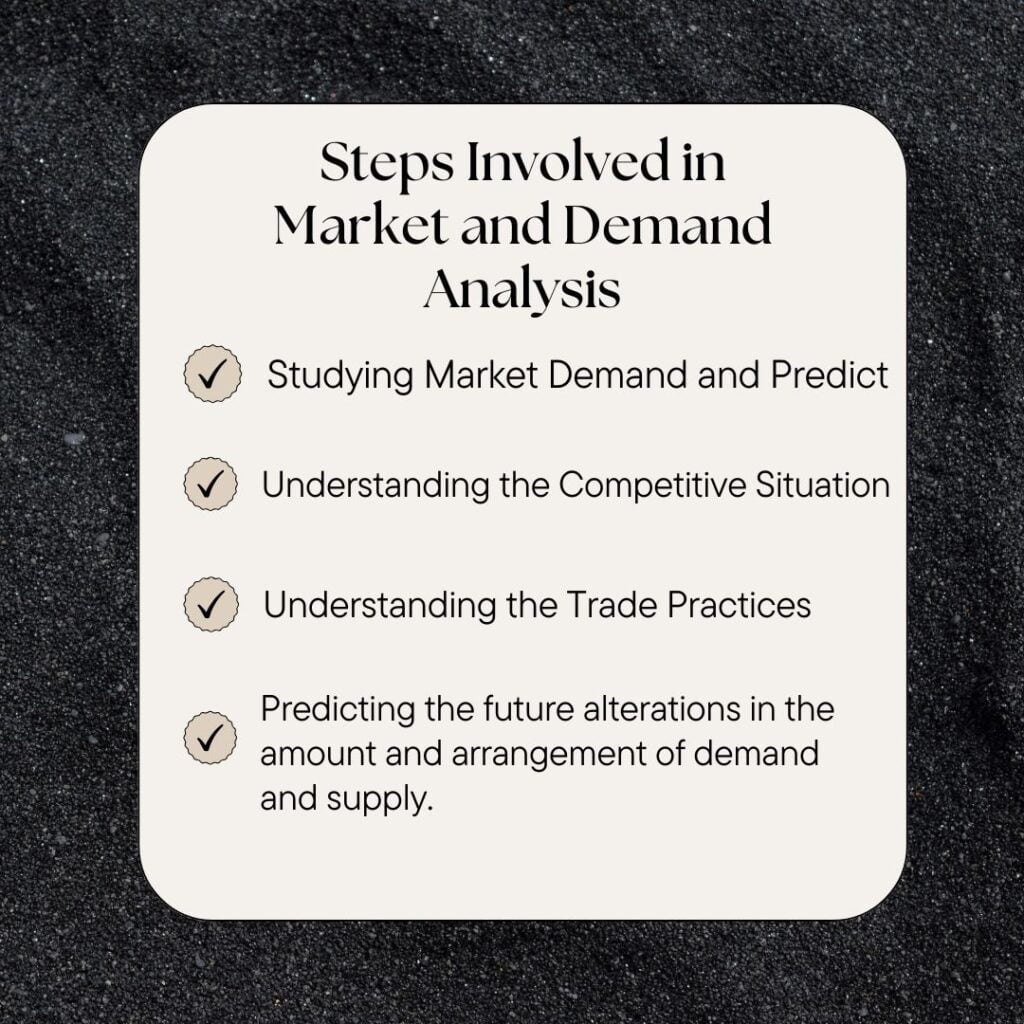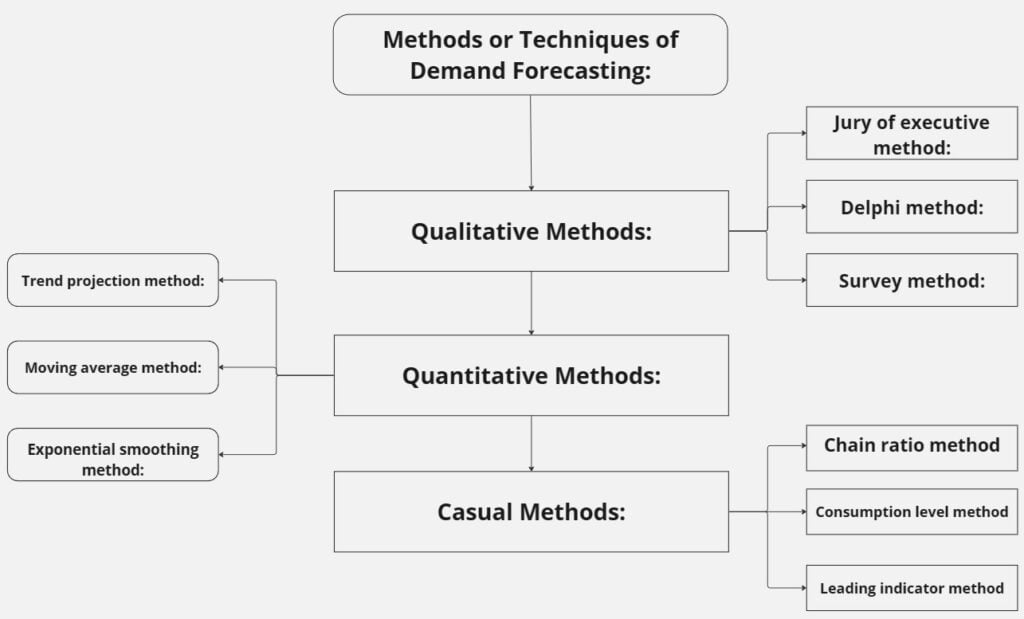When delving into the world of entrepreneurship, one of the key components that aspiring business owners must consider is market and demand analysis.
This crucial step involves thoroughly researching and understanding the market in which a business operates, as well as identifying the demand for the products or services being offered.
By conducting a comprehensive market and demand analysis, entrepreneurs can gain valuable insights that will help them make informed decisions and develop effective strategies to ensure the success of their ventures.
Market and Demand Analysis

After a business idea is generated, market and demand analysis is conducted to find out the feasibility of the idea. The key to a company’s success lies in how well it can promote its products/services.
The longevity of a business hinges on its ability to generate profits.
Earning capacity depends on the volume of sales. Marketing is the only activity that brings revenue while all other activities involve expenditure. Hence a detailed market and demand analysis should be undertaken.
Meaning of Market and Demand Analysis
Before production starts, the entrepreneur needs to analyze the demand and market for the proposed product. He or she has to anticipate who will be the possible customers for his or her product and where and when the product will be sold.
It may be noted that production has no value for the producer unless it is sold. Hence it is essential to study and analyse the market and demand for the product.
Market and demand analysis simply means analyzing the future demand potential. It is the study of the market for the product and estimates the total demand.
How to Conduct Market and Demand Analysis?

First of all, the entrepreneur should determine the objectives for the market feasibility. Then, a preliminary discussion with customers, retailers, distributors, competitors, suppliers, etc. is carried out to understand the consumer preferences, existing and potential demand, strategy of competitors, practices of distributors, retailers, etc.
The study should be such that it generates answers to the following questions:
- Who are the consumers (or customers) present and prospective?
- What is the present and future demand?
- How is the demand distributed seasonally?
- How is the demand distributed geographically?
- How much price consumers are willing to pay?
- What is the marketing mix of competitors?
- What marketing mix would the consumers accept (or expect)?
Research is required to obtain information to answer the above questions. Information obtained from the market survey shall help the entrepreneur assess the demand for his product.
It is also helpful in understanding the nature and the extent of competition and the prevailing trade practices in the market. Depending upon several factors like the availability of resources, the scale of operation, and the impact on profitability, the entrepreneur should decide the customer group, which is called the market segment.
The entrepreneur can put all of his or her efforts on the market segment determined (i.e., target market).
Steps Involved in Market and Demand Analysis

Market and Demand analysis involves the following steps:
- Studying Market Demand and Predicting Demand Trends
- Understanding the Competitive Situation
- Understanding the Trade Practices
- Predicting the future alterations in the amount and arrangement of demand and supply.
These may be briefly explained below:
1. Studying Market Demand and Predicting Demand Trends
The potential entrepreneur has to assess market demand for the product/service. A detailed study of the market to determine the size of the demand for the product is known as demand analysis.
Demand analysis involves evaluating the customers’ desire and capability to purchase goods or services. The important factors determining demand are price, nature of product/service, the income of consumers, competition, tastes, and preferences of consumers, etc.
As already stated, market demand analysis is done based on a market survey. The information to be collected from the market survey should include:
- Total demand for the product
- Segment-wise break up of the demand
- Income elasticity of the demand
- Information relating to consumers (e.g., tastes and preferences)
For demand analysis, necessary information is to be collected. Two sources are commonly used to collect information for analyzing demand.
Primary data collection:
Primary data collection is undertaken through a market survey. The market survey can be either a census survey (by taking the complete population) or a sample survey (by taking a sample from the population).
In case the product has a small market and a limited number of buyers, a census survey may be undertaken. In case the product has a large market and a diversified group of buyers, it is better to undertake a sample survey.
Market surveys or market research provide valuable information to entrepreneurs. The more he knows about his market, the greater his chance of creating customers at a profit.
Utilizing sensors to collect data: By incorporating sensors into devices or surroundings, it becomes possible to gather continuous, real-time data on user behavior, product usage, or environmental conditions. For example, wearable sensors could monitor physiological responses during surveys, while smart mirrors could collect anonymous demographic data in retail settings.
Engaging crowds through gamification: Online platforms can attract a large audience by incorporating game-like elements, encouraging participation, and generating vast amounts of data. Users may be rewarded for completing surveys, categorizing images, or contributing observations to a research initiative.
Utilizing AI for social media monitoring: Artificial intelligence can be harnessed to analyze social media discussions, unveiling valuable insights into public opinion, brand perception, and emerging trends.
Secondary data collection:
Secondary data are collected from the information already available. The sources of secondary data include the census of India, National Sample Survey reports, Planning Commission reports, UNDP reports, the information supplied by CSO, Economic Surveys, Annual publications of industrial departments, etc.
After gathering the primary and secondary data relating to market and demand, future demand is estimated. The process of estimating future demand is known as demand forecasting.
The above methods are outdated. This is a new Era or AI Era. there are so many new techniques are there:
Ethical considerations in web scraping: Extracting data from websites can be a valuable resource for secondary research. However, it is crucial to respect ethical considerations and adhere to website terms of service when employing this method.
Accessing real-time data through APIs: Many organizations now provide Application Programming Interfaces (APIs) that grant access to real-time data streams. This enables researchers to seamlessly integrate external data sources into their analysis.
Exploring unconventional data sources: Researchers are increasingly turning to alternative data sets such as satellite imagery, financial transactions, or mobile app usage data to gain fresh perspectives beyond traditional sources.
Methods or Techniques of Demand Forecasting:

All methods of demand forecasting are broadly classified into three quantitative methods, quantitative methods and casual methods.
Qualitative Methods:
These are judgemental methods in which experts translate the information collected from the primary and secondary data into qualitative estimates. The following are the important qualitative methods.
1. Jury of executive method:
Under this method, a group of experts give their views on expected future demand. Based on their views, demand is estimated.
2. Delphi method:
This method involves collecting information/opinions from a group of experts who don’t interact face-to-face. A questionnaire for demand estimation is prepared and mailed to them and they are asked to express their views.
Responses received from them are summarised and sent back to each of the experts along with questions to probe further the reasons for views expressed in the first round. This is repeated until all experts arrive at a common demand estimate.
3. Survey method:
This method involves asking the customers’ intention to buy the product for the period for which the forecast is desired.
Quantitative Methods:
These methods are based on the historical time series which is the past trend of the demand. The following are the important quantitative methods:
1. Trend projection method:
This method is very popular. This involves extrapolating the past trend to the future. This way demand can be predicted.
2. Moving average method:
Under this method, the forecasts for the next period represent a simple average or weighted arithmetic average.
3. Exponential smoothing method:
In this method, forecasts are modified in the light of observed errors.
Casual Methods:
In these methods, the forecasts are developed based on cause-effect relationships specified in an explicit quantitative manner. The important methods are:
1. Chain ratio method:
In this method, a series of factors are used to develop demand estimates.
2 Consumption level method:
In this case, demand is estimated based on consumption level. The consumption level is estimated based on elasticity co-efficient like income elasticity, price elasticity, etc.
3. Leading indicator method:
Leading indicators are variables that change ahead of other variables (the lagging variables). Hence observed changes in leading indicators may be predicting the shifts in variables that fall behind.
Understanding the Competitive Situation
To understand it in respect of a given product/service, an entrepreneur is required to answer the Competitive situation requires special attention in the whole exercise of market analysis questions such as:
- How many firms are offering the same or similar goods/services?
- What are their market shares?
- What are the strengths and weaknesses of their products?
- What kind of consumer image does each project enjoy?
- What trade practices do the competitors employ?
- Who are the major customers of each brand?
The answers to the above questions may be tabulated to understand the degree of Competition.
Understanding Trade Practices
Trade practices reveal the mode, means, and modalities of serving customers with products/services. Due to the spread of customers, or their buying habits, or even the nature of the products, it is not feasible for an entrepreneur to reach customers directly.
A host of middlemen like distributors, wholesalers, retailers, commission agents, supermarkets, and export houses are employed to provide various types of services.
A study of the prevailing trade practices (distribution channels, advertising media, etc.) would enable entrepreneurs to prepare a more realistic plan for marketing the products or services.
Predicting the Future Alterations in the Quantity and Structure of Demand and Supply
Possible future changes in the volume and pattern of supply and demand should also be estimated to assess the long-run prospects of the unit.
On the demand side, the following factors should be taken into account:
- The potentialities of the export market
- The likely changes in income and price levels
- The probable expansion of the industries using the goods to be produced
- The multiple uses of the product
- The consequent effect of globalization
- The impact of technology
- The probable market share of the product
- The effect of advertisement and sales promotion measures to be launched, etc.
On the supply side, we must consider the following factors:
- The competitive position of the proposed unit
- Existing and potential competitors
- The extent of capacity utilization
- Possibility of substitute products due to technological innovations and structural changes.
- The type of distribution channel proposed
- Unit’s cost advantages and disadvantages
- Provision for after-sales-service
- The proposed design and packaging.
Conclusion
In conclusion, market and demand analysis plays a vital role in the entrepreneurial journey, serving as the foundation upon which successful businesses are built.
By carefully examining market trends, consumer behavior, and competition, entrepreneurs can position their businesses for growth and sustainability.
Ultimately, a thorough understanding of the market and demand for their offerings enables entrepreneurs to make strategic decisions that drive innovation, attract customers, and achieve long-term success in the dynamic world of business.











1 Review